Review of Questlings, a tabletop RPG for kids to bridge worlds!
Note: This post may contain affiliate links. At no additional cost to you, I may earn a small commission from purchases made using them. TTRPGkids uses this to keep the site going. Read full disclosure here.
Jump to:
Questlings is made for ages 6+!
Questlings is made for ages 6+, but I was also able to play with my 4 year old, and he was super into it. It does recommend that a game facilitator is a little older (either a bigger kid or an adult) to help guide the younger players, and probably because a little reading is involved from the game guide.
For kids, it’s easy to follow the story and character sheet since there’s lots of symbols to and pictures to follow with some text to read, and the locations were all familiar to my kid, so he was able to connect with the setting and story.
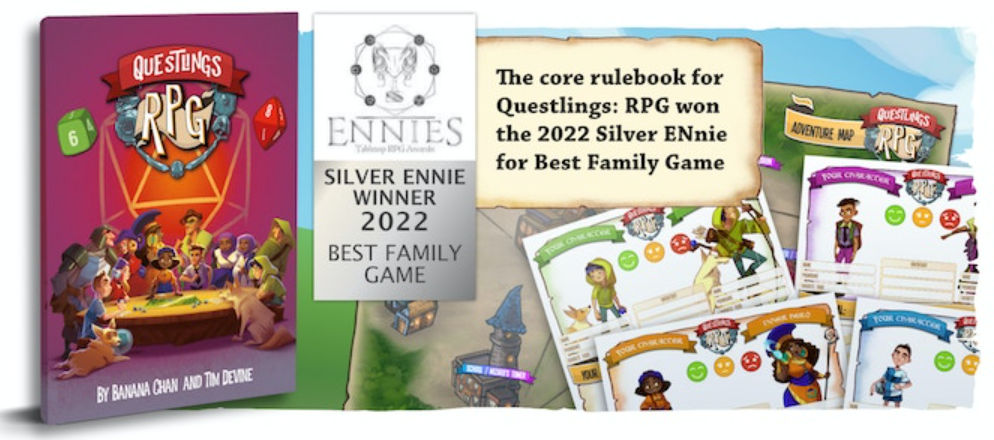
Questlings setting flips between the real world and fantasy!
Questlings is unique in that its setting takes place in two overlapping worlds, the real and the fantastic!
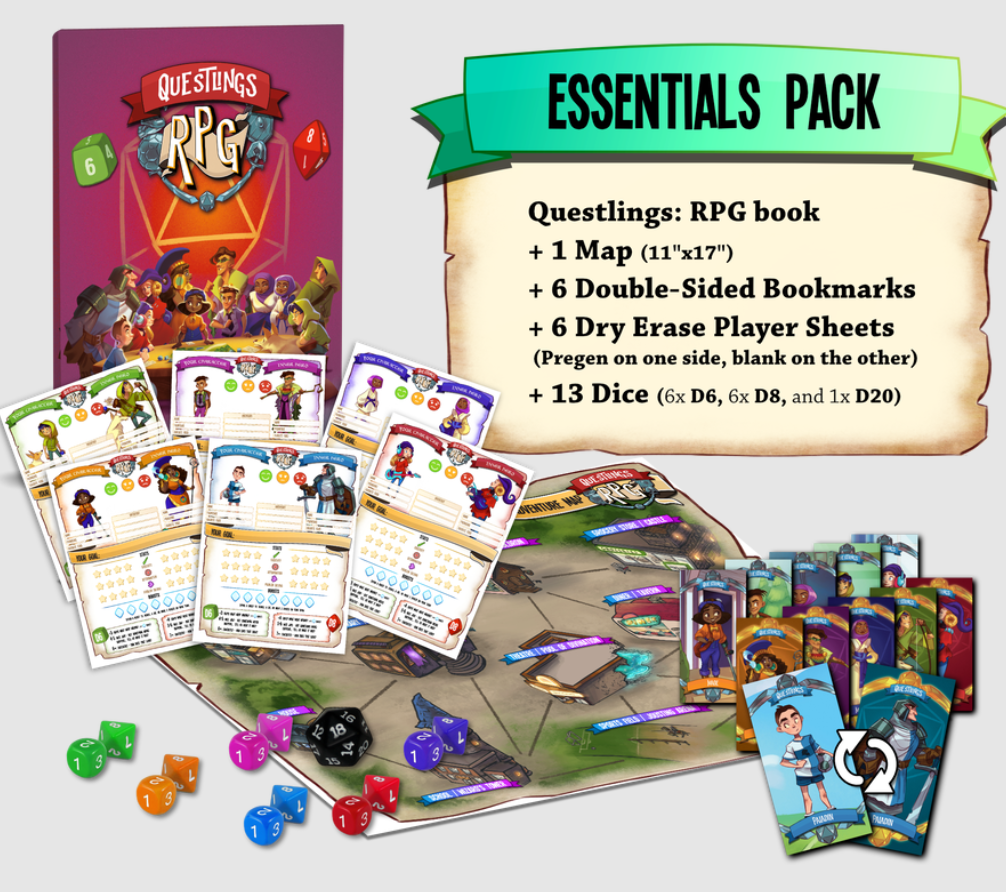
As player characters seek out items in the real world to complete their quests, the fantasy world of Questlings starts to appear! This could be the school melting away into a wizard’s tower or the shopping mall fading into a medieval market with new challenges appearing.
This flipping back and forth between realms went over really well with my kid. In some previous games, we’ve had to explain to my kid what a tavern was or what jousting was, but in Questlings, it sets up the parallel as part of the story. The sport’s field turns into a jousting field, so it’s easy to explain that jousting is a sport for knights. The diner turning into a tavern is a really clear way to explain what function a tavern can serve in the game. This transition between the real and fantasy world REALLY helped my kid to connect with some of the fantasy elements that he’s struggled with understanding or just wasn’t interested in when playing other games.
Your kid and inner hero characters in Questlings
In Questlings, your character is kind of two characters – your main character who is a kid and their inner hero.
Your main player character’s goal for the game is to collect 3 items for a quest that they’ve taken on in the real world! Then, as they go about finding those items and the real world fades into the fantasy world, your player character changes into their inner hero persona as well so they can take on the new challenges this different world presents.
For the character sheet, you spec out both your kid character and your inner hero character with name, pronouns, favorite food, and your stats, which get a +2, +1, or +0 (so very easy to track).
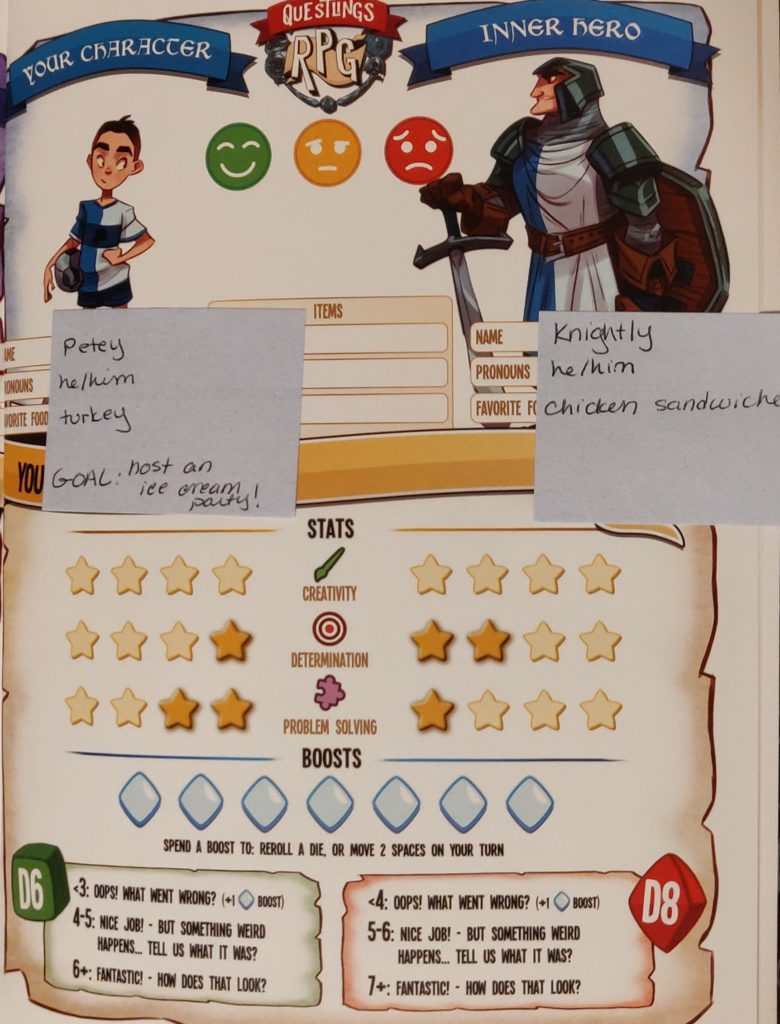
In our game, my kid chose to play as a paladin inner hero (pretty sure because we previously read and reviewed So You Want to Be a Paladin) and his kid was searching for everything needed to have an ice cream party! One place we stopped at was the ice cream shop, which turned into The Witch’s Cauldron! My kid’s character called up their inner hero to help the witch find her lost cat – he really enjoyed pretending to power up into his paladin and didn’t get confused at all with the switching between kid and inner hero.
Unique mechanics and pacing in Questlings
Rules lite dice mechanics for both your kid character and your inner hero
Because you have both a real world and fantasy character in Questlings, they each have slightly different abilities. Your kid character rolls a 1d6 while your inner hero rolls 1d8, and beyond that, the mechanics run relatively the same.
Your roll plus your stats for each determines if you get an OOPS, a “nice job, but…”, or a FANTASTIC!
This mechanic was easy for my kid to track since we’re only using two dice, and the outcomes were easy to understand as well. The OOPS and the “nice job, but…” also both really drive the story versus just being a “failed attempt” – this was a great fail-forward kind of game.
Boosts to reward kindness and to make up for an OOPS
Questlings has a boost mechanics available too – boosts allow players to take on a special ability, like rerolling a die, moving extra spaces on a map, or getting a hint. Boosts are tracked by filling in little diamonds on the character sheet, so they’re easy to see and use.
You can gain boosts by either rolling an OOPS or by doing something particularly cool or kind (like helping another player).
This both helps to take the sting out of rolling low and turns it into something extra special for later (in our game, I compared it to learning from your mistakes) AND it helps to avoid having repeated low rolls and the frustration that comes with that, since you can use the boost to reroll a low number.
Rewarding kindness and helpfulness with a boost is great too for promoting collaboration between players and being willing to maybe go out of the way to help an NPC.
Player spotlights helping to pace individual stories
To help every kid playing to be seen and be able to pursue their individual story while still working as a team, there’s a very useful spotlight mechanic that rotates the attention from player to player.
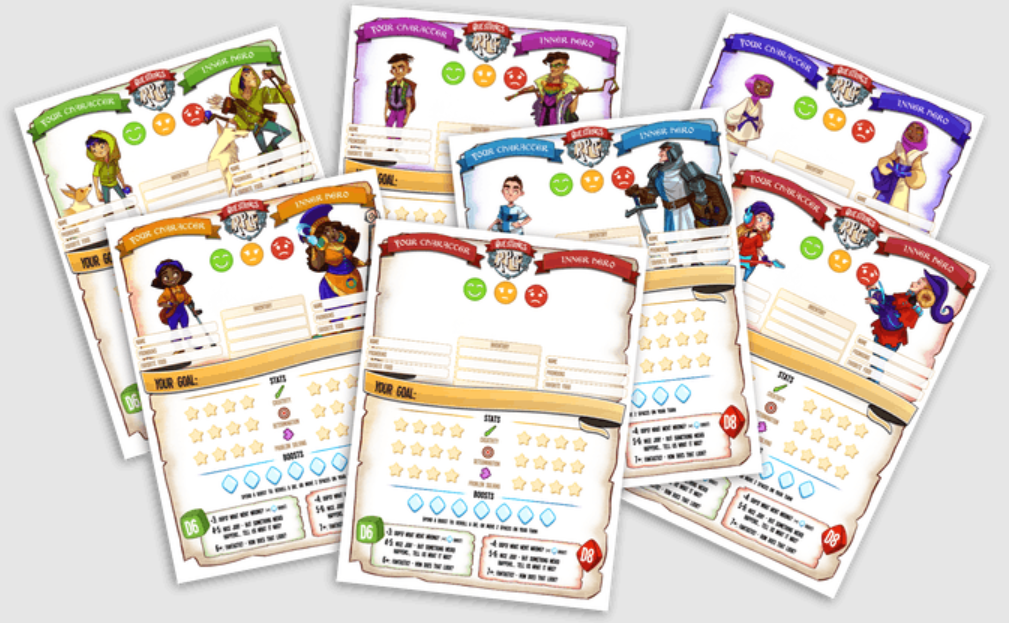
In each scene, one spotlight player is designated, and they are the primary kid for that game. Everyone else is still involved, but the spotlight player answers the questions about that area and takes the lead for the scene’s action.
I really liked this for a couple reasons:
First, this helps to pace the experience of each player so you bounce scenes around from character A to character B to character C instead of running a whole arc on character A and the other players getting bored. It guarantees everyone will get to shine.
Second, it makes sure that quiet kids get a chance to speak and the more active kids have a frame for when to take a step back (and that they’ll be at the forefront again soon). It’s a great way to emphasize taking turns without having rigid rules about when to speak or not.
What did my kid think about Questlings?
My kid’s initial response was him geeking out about seeing the characters from the So You Want to Be a Paladin book in an actual game! Once he side-by-side compared the game to the book to show me they were the same (and we agreed he could play a paladin), the story itself was very easy to get into. Having the analogies from real world locations to fantasy locations made it really easy for him to connect, and he loved the pictures showing the buildings turning into their fantasy counterparts.
Overall thoughts on Questlings
Questlings has a great setting and mechanics that are both made specifically for kids and with attention to their needs and interests in mind. The artwork is great, and I love that it companions with the So You Want to Be a… series to help connect the game to even more stories. This game was creative, well done, and a lot of fun to play with my kid!
Find a copy of Questlings
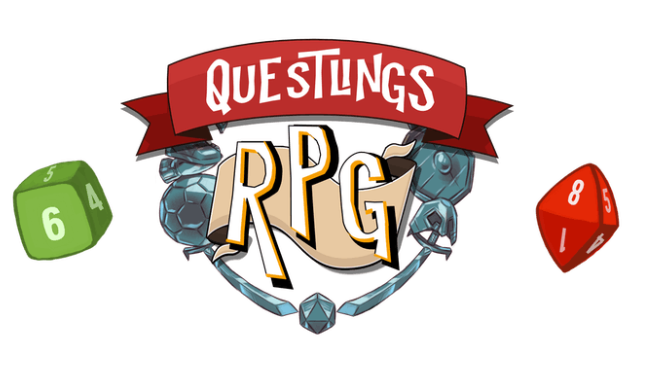
You can find Questlings on the Letiman Games site or DriveThruRPG
I hope you get the chance to check out and enjoy Questlings too! Let me know below if you try it out and what your thoughts are!If you liked this post, make sure to subscribe to the TTRPGkids monthly newsletter to stay up to date on the latest reviews, tips and tricks, game and podcast list updates, and more! Thank you for playing tabletop RPGs with your kids and sharing this awesome hobby with the next generation!

2 thoughts on “Review of Questlings, a tabletop RPG for kids to bridge worlds!”